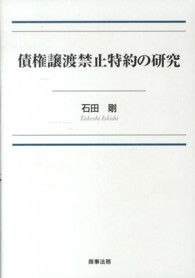- ホーム
- > 洋書
- > 英文書
- > Literary Criticism
基本説明
No book until now has specifically addressed the nature of the relationship between Shakespeare and Victorian women. Gail Marshall gives an account of the actresses who played an essential part in redeeming Shakespeare for the Victorian stage, the writers who embraced him as part of the texture of their own writing as well as their personal lives, and those women readers who, educated to be alert to the female voices of Shakespeare, often went on to re-read Shakespeare for their own ends. Dr. Marshall argues that women form a fundamental part of the narrative of how the Victorian Shakespeare was made, and that translation, rather than terms such as appropriation or adaptation, is the most appropriate metaphor for understanding the symbiosis between Shakespeare and Victorian women.
Full Description
Much has been written on the cultural significance of Shakespeare, his influence on particular periods, and his appropriation and subsequent transformation. However, no book until now has specifically addressed the nature of the relationship between Shakespeare and Victorian women. In this book, Gail Marshall gives an account of the actresses who played an essential part in redeeming Shakespeare for the Victorian stage, the writers who embraced him as part of the texture of their own writing as well as their personal lives, and those women readers who, educated to be alert to the female voices of Shakespeare, often went on to re-read Shakespeare for their own ends. Dr Marshall argues that women form a fundamental part of the narrative of how the Victorian Shakespeare was made, and that translation, rather than terms such as appropriation or adaptation, is the most appropriate metaphor for understanding the symbiosis between Shakespeare and Victorian women.
Contents
Introduction; 1. Shakespeare and Victorian girls' education; 2. Elizabeth Barrett Browning and Shakespeare: translating the language of intimacy; 3. 'She had made him, as it were, the air she lived in': Shakespeare, Helen Faucit and Fanny Kemble; 4. George Eliot and Shakespeare: defamiliarising 'second nature'; 5. Socialism, nationalism and Stratford: Shakespeare and the New Woman at the fin de siècle; 6. Shakespeare and the actress in the 1890s.
-

- 和書
- 債権譲渡禁止特約の研究



